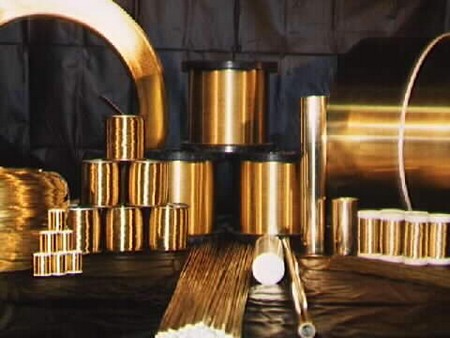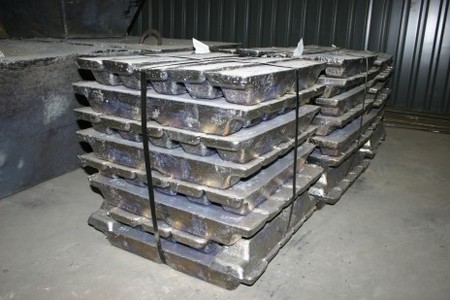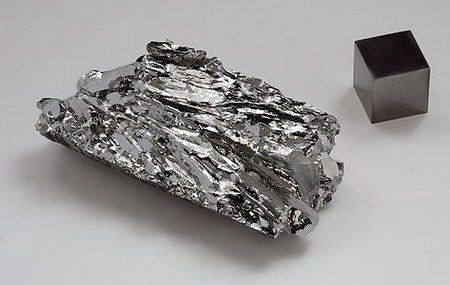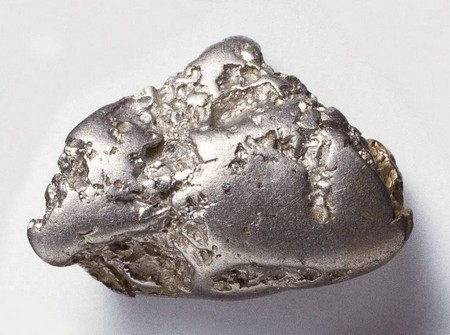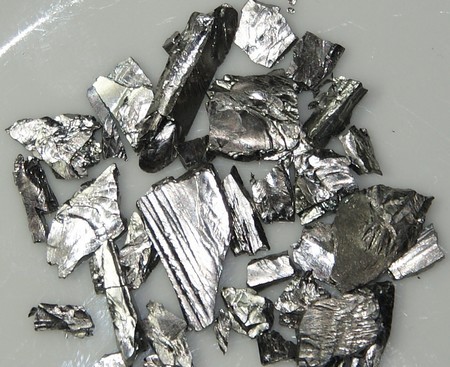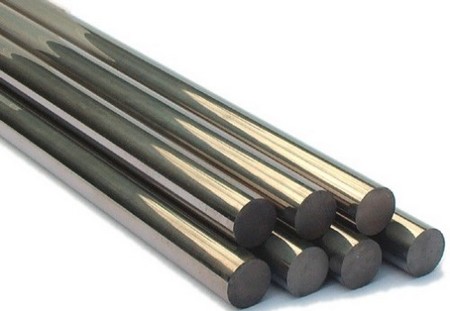The term metal is always hard to define. However, a dictionary definition of metal is, “a substance that is usually hard and shiny and that heat and electricity can travel through.” Metals are found with changing degrees of hardness, malleability, ductility, hardness and density. Malleability is a property of being easily molded into different shapes without breaking or cracking while ductility is property given to the metals that can be made into thin wire. Almost all the metals have a certain melting point and can be combined with other metals by melting to form alloys. It is important to note here that all the metals except mercury are solid at normal temperatures. Following are given some of the different types of metal.
Aluminum
Aluminum is lightweight metal that is commonly used all over the world. In its raw form, it is extremely strong and to make it suitable for use is often alloyed with silicon. Generally 1 percent of silicon of silicon is used with aluminum. However, in case of casting alloys, 12 percent of silicon is used.
Raw aluminum also has a bad tolerance to corrosion, however, the self generating oxide layer enable it to be used in environments more prone to corrosion.
Raw aluminum has poor corrosive resistance, but thanks to a protective self generating oxide layer, the material can be used in corrosive environments. Anodizing process is used to check the quality of oxide layer.
Foamed Aluminum
Where light aluminum structures are required, foamed aluminum is used. The aluminum is foamed by mixing the aluminum with the titanium hydride prior to casting as a result of which hydrogen gas foams the aluminum. Foamed aluminum has a porous surface and an additional layer of solid aluminum is used to cover this. Contrary to honeycombed aluminum compositions, the structures of foamed aluminum are used in the temperature range similar to solid aluminum.
Bismuth
Bismuth is a heavy, fragile and white crystalline trivalent metal with a pink shade. Chemically, bismuth is similar to arsenic and antimony. The chemical symbol for bismuth is ‘Bi’ with an atomic number of 83. Bismuth is also known as the most naturally diamagnetic metal among all others.
Bismuth is widely used in cosmetics and medical procedures. One of the major reasons behind the popularity of bismuth metal is the fact that bismuth is used as a substitute for the lead as lead is highly toxic. Therefore, bismuth has gain considerable commercial value over the last few years.
Brass
Brass is a kind of yellow allow usually made of copper and zinc and is widely used in musical instruments, rifle cartridges and cutlery. The alloy of brass which is low in zinc content, i.e. 30 percent of it is considered to have a good formability property and often refer to as cartridge brass. However, the alloy with rich zinc content shows good casting and machining properties.
Bronze
Bronze is a type of metal which is hard, have good weather tolerance and good casting properties. It is basically a reddish alloy commonly used in church bells, canons, bearings and in casted sculptures. Copper has a major share in the alloying of bronze. Tin and nickel are some of the other alloying elements.
Cadmium
It is chemical element that has its chemical symbol as ‘Cd’ with atomic number 48 in the periodic table. Cadmium is a transition element that is soft, bluish-white and rare. It is believed that cadmium can cause cancer and normally found with the zinc ores. The major use of cadmium can be seen in batteries and pigments like plastic products.
Chromium
Chromium is a metallic element that is commonly used in chromium plating for the purpose of decoration, corrosion and for wear protection. Chromium is also used as an alloying element in stainless steel. Unlike pure chromium which is ductile and mostly produced in laboratories, the commonly found chromium is hard and delicate at 700°C and above this temperature the element turns ductile. Similarly, chromium shows a good resistant against corrosion and oxidation at temperature of about 1100°C. This is possible because of the presence of resistant film on the surface.
Cobalt
Cobalt is a metallic chemical element that has its symbols as ‘Co’ in the periodic table. This hard, lustrous, silvery-gray metal occurs in variety of ores. Cobalt is normally used to prepare magnetic, wear resistant, high-strength alloys. The compounds of cobalt are used to produce ink, varnishes and paints.
Copper
Copper is a good conductor of electricity. It is red, slightly expensive and soft chemical element. It is widely used in the manufacturing of electric wires. Other than that it is also used in water pipes, roof plates, and in some old cooking appliances. In bronze (with tin) and brass (with zinc), copper is an important alloying element.
Gold
A yellow colored precious chemical element used in making coins, jewelry, decorative objects etc. In the periodic table, its symbol is Au (derived from Latin Aurum) and its atomic number is 79. For many centuries, this metal has remained in use as money. Gold is commonly found in rocks in the form of nuggets or lumps. It also occurs in veins under the surface of earth and also in alluvial (mud or sand deposits) deposits. It is compact, lustrous and has good properties of being malleable and ductile. It is also used in branded watches, and there’s a designated watch repair service for this luxury brand.
The most interesting fact of gold as metal is, it sets the monetary standards for both the International Monetary Fund (IMF) and the Bank for International Settlements (BIS). XAU is known to be the currency code of gold bullion (or bars). Beyond its monetary significance, gold is a popular choice for investment due to its stability and enduring value. To delve deeper into the world of gold investment, learn more here.
Gold is both univalent and trivalent if we take it chemically. Although, gold is not known to react with other chemical elements, it still gets affected by chlorine, fluorine, aqua regia and cyanide. It makes mixtures of alloys when dissolves in mercury, but at no place it reacts with it. Unlike silver and base metals, gold is insoluble in nitric acid and that is the reason nitric acid has used for centuries to verify the gold presence in an object. This technique is also called ‘acid test’.
Cast Iron
Cast iron is a term used to refer to the family of alloys (ferrous alloys) made of iron, carbon about 2 to 4.5% and about 3.5% of silicon. Cast iron is available in several varieties.
If we talk about gray cast iron, it has low ductile properties, dampens vibrations and fragile. Carbon is found in the form of graphite flakes in gray cast iron. White cast iron is another variety of cast iron that is hard, possesses good resistant and is fragile. In white cast iron, the carbon is found in extremely hard ceramic particles known as cmentite.
Ductile iron as the name suggests shows good ductile properties. It is also shows good resistant against shocks. Ductile iron is formed by giving a heat treatment to gray cast iron. Malleable iron is another variety which is sturdy, shock resistant and ductile as well.
Lead
Lead is a soft, heavy metal mostly used in ship keels and in fishing nets sinkers to add weight. Another important use of lead can be seen where it is used as insulation next to radioactivity. Previously, lead was commonly used in roof windows and in shotguns. But as the poisonous and toxic properties of lead appeared on the scene, the use of lead discarded.
Magnesium
Magnesium is another important light, silver-white metallic chemical element that gives a bright white flame when burned. Magnesium is widely used in place of aluminum with a view to reduce weight. Magnesium is a reactive metal and commonly used in the manufacturing of car wheels and power saws.
Mercury
Mercury, a poisonous silver liquid metal, widely used in thermometers and is also referred to as quicksilver. In the periodic table, it has its chemical symbol as ‘Hg’ (derived from Latinized Greek ‘hydrargyrum’ which means ‘watery or liquid silver’) and has an atomic number of 80. It is known to be one among other four elements (caesium, francium, and gallium, and the non-metal bromine) that take the liquid form at or near room temperature and pressure.
Other than thermometers, it is also used in barometers and several other scientific apparatus. Because of its toxic properties, its use in thermometers has greatly been reduced and is replaced by alcohol filled, digital and thermistor-based instruments. However, mercury thermometers still have a role to play in several different scientific research applications.
This metallic chemical element is found in deposits all over the world and is harmless in an insoluble form like in mercuric sulfide; however, it becomes toxic in soluble states like those of mercuric chloride or methylmercury.
Molybdenum
A chemical element and a silver gray metal that is brittle and used in alloy steels. In the periodic table, it is represented by a symbol ‘Mo’ and has an atomic number 42. Among all the other elements, molybdenum is known to possess sixth highest melting point. This high melting point makes it useful for strong steel alloys. It is present in animals and plants in less amount and excessive presence can be poisonous in few animals. It was in 1778, when Carl Wilhelm Scheele discovered this element. It took three years before it was isolated by Peter Jacob Hjelm in 1781.
On the Pauling scale, it has an electro-negativity of 1.8 and an atomic mass of 59.9 g/mole. It is a transition metal that doesn’t react with oxygen or water, especially at room temperature. On higher temperatures, it forms the molybdenum trioxide by reacting with oxygen, i.e. given by the reaction: 2Mo+ 3O2 = 2MoO3.
It is one of the five elements having a high melting point, i.e. 2623°C. The other elements having high melting points are tantalum, osmium, rhenium and tungsten. It requires a temperature of over 600°C to burn.
By 4 May, 2007, its value was recorded as $65,000 per metric ton (or per tonne). From 1997 to 2007, its value remained $10,000. However, by June, 2005, the value of molybdenum reached $103,000 per metric ton or tonne.
Nickel
Nickel is a hard silver-white metal that is used in the making of some types of steel or other alloys. Nickel coating is used on the surfaces for several different reasons such as for decorative purposes, erosion and corrosion resistant.
On higher temperatures, nickel alloys shows extremely excellent resistant against corrosion. Chromium, cobalt and molybdenum are some of the most commonly used alloying elements in nickel.
When it comes to nickel, it is strong, showing good resistant against corrosion and erosion and also robust. Nickel is widely used in stainless steel and other than that nickel alloys (superalloys) are commonly used in the preparation of appliances or equipments that work under immense temperatures such as engine components, rockets etc.
Platinum
It is another chemical element which has its symbol ‘Pt’ in periodic table with atomic number 78. It is a silver-gray precious transition metal that is heavy, malleable and ductile. Platinum has good-resistant against the corrosion. It usually found in nickel and copper ores together with some other native deposits. It is widely used in automobile emission control devices, laboratory equipments, jewelry, dentistry and electrical contacts. ‘XPT’ is an ISO currency code used for platinum.
Palladium
A chemical element has ‘Pd’ its chemical symbol in the periodic table and atomic number of 46. It is a rare silver-white transition metal that chemically looks like platinum. In 1803, it was discovered in platinum ores. It is given its name after the asteroid Pallas by William Hyde Wollaston.
It occurs as a free metal and afterwards alloyed with metals in platinum group. Palladium is used in different ways such as catalysis in catalytic converters in cars; on carbon it is used in organic chemistry and other similar chemical reactions. It is also used in the making of jewelry. ‘XPD’ is an ISO currency code for palladium.
Silver
Silver is a grayish-white precious metal represent by the symbol ‘Ag’ (derived from Latin ‘Agentum’) in periodic table and has an atomic number of 47. Being a metal, it possesses good thermal and electrical conductivity. Silver can be found as a free metal or in several minerals like argentite and chlorargyrite. Majority of the time, silver is obtained as a secondary product of copper, gold, lead, and zinc mining.
Since primitive people to present, silver has been used in one way or another. Being considered as a precious metal, it was used to make coins, currency, jewelry such as vintage diamond engagement rings, cooking utensils, and ornaments. ‘XAG’ is an ISO currency code given to silver bullion. If you’re looking for the best jewelry, then you may check out this unique garnet jewellery in Brisbane.
Steel
Steel is a strong hard metal that is composed of a mixture of iron and about 2.1% of carbon. In order to make it more strong, the quantity of carbon contents are altered in the alloy, i.e. more the carbon contents in the alloy, stronger will be the metal. There are three standards of steel in respect to carbon, i.e. low carbon steel (having less than 0.3% carbon) is used in the manufacturing of nuts, bolts, sheets and tubes; Medium carbon steel (0.3-0.6% of carbon) is used in automotive and machinery equipments; and High carbon steel (over 0.6% of carbon) is known to be sturdy, tough, and erosion resistant used in the making of cutlery, springs, and cutting tools.
High Tensile Steel
High tensile steel is another metal which is ten times stronger than the tensile strength of wood and twice as stronger than mild steel. By increasing the tensile strength of the metal, the hardiness of metals is lessened. As a safety precaution, for large structures, the amount of acceptable stress is lowered.
Stainless Steel
Stainless steel is a kind of steel that is strong, hard, show good resistant against corrosion and ductile properties. Stainless steel is comprised of 11% of chromium, nickel and some other alloying elements. On exposure to oxygen, a hard thin layer develops on the surface that helps protect it against the corrosion. If you remove this thin layer, it will come back again. The strength of stainless steel depends on the carbon contents. Higher the carbon contents mean more strength, but lower resistant against corrosion.
Tantalum
Tantalum was previously known as tantalium. It is a chemical element that is hard and silver-gray in color. In the periodic table, it is represented as ‘Ta’ and has an atomic number of 73. This shiny transition metal shows good resistant against corrosion and is found in the mineral called tantalite.
Tellurium
It is another chemical element that is found in the sulfide ores. Chemically, it looks similar to tin, and is related to selenium and sulfur. It is lustrous silver-white element which is brittle, having ‘Te’ its symbol in periodic table with an atomic number of 52.
Tin
It is a soft silver-white metal that is usually used with other metals or used to cover them to avoid corrosion such as foot tins, casseroles etc. Below the room temperature, pure tin breaks apart into white powder called tin pest. In past, tin was used to make mugs, household plates and canclestics. Bismuth, antimon and lead are some alloying elements for tin.
Titanium
It is a silver-white metal that is used to make different strong but lightweight materials. It is good against corrosion and keeps intact both in room and higher temperatures. It is for this reason, titanium is widely used in the application like aircrafts, jet-engines, racing cars, chemical and marine parts etc. aluminum, vanadium, and magnesium and molybdenum are some of the different alloying elements.
Tungsten
Among all the other metals, tungsten is known to have the highest melting point, i.e. 3410°C. This makes it a strong and hard metal. However, it is fragile, and shows poor resistant against corrosion. Tungsten along with its alloying elements is used in the applications demanding more than 1650°C of temperature such as nozzle of throat lines in missiles, hottest parts in jet and rocket engines. In incandescent bulbs, the filament wire is also made from pure tungsten using the powder technology.
Zinc
It is a bluish-white metal which is inexpensive and has good weather proof properties. It is commonly used in the roofs and roof gutters. Before stainless steel, zinc was used to make kitchen utensils. Because of having low melting point and good casting properties, it is often preferred in materials where low strength is enough such as beer openers, door handles. Zinc along with copper is a vital alloying element in brass.

